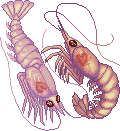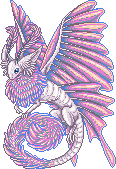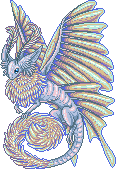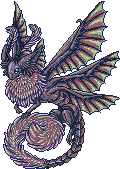Valentine's Day Creatures! #967-71
Posted: February 14th, 2019, 12:11:31 am
They're here! Flooding up to and including Feb 20
All will be able to breed
Stealing thisto start from BBkat's post--thanks, BBkat! And thanks to all who are posting hatchies, adults, etc. as we go! Makes my job so much easier!
#967: Charubi, stream, permanent

This egg has a tiny heart.
Charubi female/male hatchling


Hatchling:
Charubi, female, male


Adult:
General:
Sprite art: DarrkestDrow | Description: Raneth
#968: Blushing Charubi, stream, limited

This egg has a tiny heart.
Blushing Charubi female/male hatchling


Hatchling:
Blushing Charubi adult, female, male


Adult:
General:
Sprite art: DarrkestDrow | Description: Raneth
#969: Krill, stream, limited

These jelly-like eggs are fused together. They only ever seem to move together.
Krill female/male hatchling

Hatchling:
Krill female/male adult

Adult:
General:
Sprite art: Mysfytt | Description: PKGriffin
#970: Daius Esplendid, stream, limited, obtainable by other means after event

This egg has a pink fluffy tail curled around it.
Daius Esplendit female/male hatchling


Hatchling:
Daius adult, female, male


Adult:
General:
Sprite art: Lazuli and Xenomorph | Description: Lazuli
#971: Noctus Esplendid, stream, limited, obtainable by other means after event

This egg has a pink fluffy tail curled around it.
Noctus Esplendit male/female hatchling


Hatchling:
Noctus adult, male, female


Adult:
General:
Sprite art: Lazuli and Xenomorph | Description: Lazuli
All will be able to breed
Stealing thisto start from BBkat's post--thanks, BBkat! And thanks to all who are posting hatchies, adults, etc. as we go! Makes my job so much easier!
#967: Charubi, stream, permanent

This egg has a tiny heart.
Charubi female/male hatchling


Hatchling:
Spoiler
Charubi hatchlings are very clingy, always staying a little behind their magi. Charubi hatchlings follow their magi everywhere, no matter where they go. They require constant attention, and if their magi doesn't pet them at least once an hour they will begin keening in a very high-pitched, annoying sound. Having a Charubi hatchling usually means a tiny deer sleeping curled up next to you in bed. Thankfully, as long as they get enough attention, they will be content and happy, and repay their magi with cozy affection.
Charubi, female, male


Adult:
Spoiler
Upon reaching adulthood, Charubi deer begin their quest for their devoted companion. This may mean finding another deer at the Keep, or even venturing into the wilds to find the right one. This behavior isn't well understood. Companion does not always mean mate, as Charubi deer will mate outside their union. And there is no way to tell which deer will bond with which. Magi have tried arranging unions, only for their deer to choose completely different companions. And in the sad case where one's companion dies, the deer will venture to find another. But eventually, every Charubi deer will always find another deer, and the two will become inseparable. They will eat together, sleep together, and even venture out on dangerous quests together if one deer's magi leaves the Keep with it in tow. A magi with one Charubi deer is almost certain to end up with two once it reaches adulthood, and should be prepared for the responsibility.
Spoiler
Charubis are cheeky creatures. They are very persistent about getting attention from their chosen companions. A companion pair of Charubi are literally never apart, but while they are devoted, they also take out their frustrations on each other in harmless, sometimes humorous ways. They will nip each other's ankles or even rear ends to get attention, and if the two companions are both male, will sometimes butt their antlers together in mock fights. Whatever mischief they make for each other, all will be forgiven once one deer picks up a leaf and places it on its companions back. This gesture seems to be one of reconciliation or maybe a way to ask for forgiveness for whatever annoying thing the deer did. Once this happens, they will coexist happily for a while, content to munch their favorite meals or to follow each other wherever each one goes.
#968: Blushing Charubi, stream, limited

This egg has a tiny heart.
Blushing Charubi female/male hatchling


Hatchling:
Spoiler
Charubi hatchlings are very clingy, always staying a little behind their magi. Charubi hatchlings follow their magi everywhere, no matter where they go. They require constant attention, and if their magi doesn't pet them at least once an hour they will begin keening in a very high-pitched, annoying sound. Having a Charubi hatchling usually means a tiny deer sleeping curled up next to you in bed. Thankfully, as long as they get enough attention, they will be content and happy, and repay their magi with cozy affection.


Adult:
Spoiler
Upon reaching adulthood, Charubi deer begin their quest for their devoted companion. This may mean finding another deer at the Keep, or even venturing into the wilds to find the right one. This behavior isn't well understood. Companion does not always mean mate, as Charubi deer will mate outside their union. And there is no way to tell which deer will bond with which. Magi have tried arranging unions, only for their deer to choose completely different companions. And in the sad case where one's companion dies, the deer will venture to find another. But eventually, every Charubi deer will always find another deer, and the two will become inseparable. They will eat together, sleep together, and even venture out on dangerous quests together if one deer's magi leaves the Keep with it in tow. A magi with one Charubi deer is almost certain to end up with two once it reaches adulthood, and should be prepared for the responsibility.
Spoiler
Charubis are cheeky creatures. They are very persistent about getting attention from their chosen companions. A companion pair of Charubi are literally never apart, but while they are devoted, they also take out their frustrations on each other in harmless, sometimes humorous ways. They will nip each other's ankles or even rear ends to get attention, and if the two companions are both male, will sometimes butt their antlers together in mock fights. Whatever mischief they make for each other, all will be forgiven once one deer picks up a leaf and places it on its companions back. This gesture seems to be one of reconciliation or maybe a way to ask for forgiveness for whatever annoying thing the deer did. Once this happens, they will coexist happily for a while, content to munch their favorite meals or to follow each other wherever each one goes.
#969: Krill, stream, limited

These jelly-like eggs are fused together. They only ever seem to move together.
Krill female/male hatchling

Hatchling:
Spoiler
Young krill are unable to swim against the rough ocean currents and so spend most of their early lives drifting in the open ocean. They're filter-feeders, so most of their food (tiny algae and occasionally even smaller animals) comes along with them. They remain close to their hatchmate, using their tiny legs to swim closer together if they start to drift apart. It doesn't take long for them to reach their full size -- usually just a few weeks.

Adult:
Spoiler
Adult krill can reach lengths of up to fifteen centimeters, though most are less than a third that size. They remain fairly small creatures, especially compared to the much larger animals that eat them. As adults, krill are capable of swimming against weak currents. They use this to their advantage to avoid predators during the day, preferring to spend time at depth while diurnal predators are active, and wandering closer to the surface at night. However, strong currents can produce upwells that sweep swarms of krill to the surface of the water where they can incite a feeding frenzy among their usual predators. Some krill can escape these events by diving to lower depths, though they can also shed their exoskeletons to use as a decoy for a hungry predator. Whether they escape or not, hatchmate pairs stick close together to ensure they endure the same fate.
Spoiler
The cold northern and southern oceans are home to many marvelous creatures, but almost all of them depend, in one way or another, on these tiny crustaceans. Krill are the base of the arkenian food chain, at their peak season forming masses that weigh millions of tons. Whales, seals, penguins, leviathans, fishes, and many other creatures feed largely or exclusively on krill. The small invertebrates are interesting as more than just food, however. Accustomed to living in enormous clusters, krill dislike being alone. To ensure this, their eggs are always laid in pairs, and they remain with their hatchmate for life. They are never far from one another, and can be identified by their beating hearts, which are visible through their semitransparent exoskeleton and beat in sync with one another.
#970: Daius Esplendid, stream, limited, obtainable by other means after event

This egg has a pink fluffy tail curled around it.
Daius Esplendit female/male hatchling


Hatchling:
Spoiler
Young esplendits hatch completely helpless, flightless and unable to do much more than wiggle and chirp. Upon first hatching, all esplendits are light pink and wingless, and it is very difficult to tell the daius and noctus hatchlings apart based on appearance. As they age, their colors fade into their telltale pastel or dark hues, long before their wings grow in. Until then, the most reliable way to tell them apart is by observing when the hatchling is most active. Daius hatchlings wake at dawn and are active all day, begging for sugary treats and sniffing about flowers. Noctus hatchlings wake at dusk, begging for harsher flavors like fermented fruit and enjoying the light of the moon.


Adult:
Spoiler
Though as hatchlings esplendit hatchlings are difficult to tell apart, it is quite simple to identify them as adults. Daius esplendits come in soft, pastel colors with butterfly-like wings and sweet, kind personalities. They build relationships based on selfless acts, assisting in tasks and presenting one another with treats, including nectar, sap, and candies. The daius esplendits choose their mates over many years, patiently searching through their colony and others for their permanent mate. Noctus esplendits have quite different attitudes. Each night during their mating season, they arrive coated in droplets of alcohol and with slices of fermented fruit, and they dance through the tree tops on foot and on wing to attract mates.
Spoiler
Esplendits grow magnificent wings upon reaching maturity. Once grown, daius esplendits begin their journey to find their permanent mates. This may take many years, but once they have found each other they stay together for life, raising young in a small family group. Noctus esplendits, out of mating season, begin working to raise the colony's young as a large group. Rarely does a noctus parent raise its own young, instead giving it over to the colony to be raised by many members.
#971: Noctus Esplendid, stream, limited, obtainable by other means after event

This egg has a pink fluffy tail curled around it.
Noctus Esplendit male/female hatchling


Hatchling:
Spoiler
Young esplendits hatch completely helpless, flightless and unable to do much more than wiggle and chirp. Upon first hatching, all esplendits are light pink and wingless, and it is very difficult to tell the daius and noctus hatchlings apart based on appearance. As they age, their colors fade into their telltale pastel or dark hues, long before their wings grow in. Until then, the most reliable way to tell them apart is by observing when the hatchling is most active. Daius hatchlings wake at dawn and are active all day, begging for sugary treats and sniffing about flowers. Noctus hatchlings wake at dusk, begging for harsher flavors like fermented fruit and enjoying the light of the moon.


Adult:
Spoiler
Though as hatchlings esplendit hatchlings are difficult to tell apart, it is quite simple to identify them as adults. Daius esplendits come in soft, pastel colors with butterfly-like wings and sweet, kind personalities. They build relationships based on selfless acts, assisting in tasks and presenting one another with treats, including nectar, sap, and candies. The daius esplendits choose their mates over many years, patiently searching through their colony and others for their permanent mate. Noctus esplendits have quite different attitudes. Each night during their mating season, they arrive coated in droplets of alcohol and with slices of fermented fruit, and they dance through the tree tops on foot and on wing to attract mates.
Spoiler
Esplendits grow magnificent wings upon reaching maturity. Once grown, daius esplendits begin their journey to find their permanent mates. This may take many years, but once they have found each other they stay together for life, raising young in a small family group. Noctus esplendits, out of mating season, begin working to raise the colony's young as a large group. Rarely does a noctus parent raise its own young, instead giving it over to the colony to be raised by many members.

